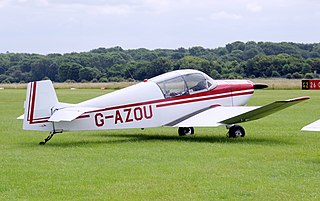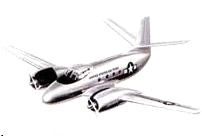Related Research Articles

The Beechcraft King Air is a line of American utility aircraft produced by Beechcraft. The King Air line comprises a number of twin-turboprop models that have been divided into two families. The Model 90 and 100 series developed in the 1960s are known as King Airs, while the later T-tail Model 200 and 300 series were originally marketed as Super King Airs, with the name "Super" being dropped by Beechcraft in 1996.

American Aviation Corporation was an American aircraft manufacturer based in Cleveland, Ohio in the 1960s, which produced light single-engine aircraft. In 1972 it became the Grumman American Aviation Corporation.

The Gulfstream American GA-7 Cougar is an American all-metal, 4-seat, twin-engined light aircraft. The Cougar was a twin-engine development of the Gulfstream American AA-5B Tiger and traces its lineage to the AA-1 Yankee Clipper and the Bede BD-1.

The Beechcraft 60 Duke is an American-built twin-engine fixed-wing aircraft created by Beechcraft. The aircraft has retractable tricycle landing gear and a pressurized cabin. The two piston engines are turbocharged and the turbochargers also pressurize the cabin with bleed air.

The Cessna 421 Golden Eagle is an American six or seven seat twin-engined light transport aircraft, developed in the 1960s by Cessna as a pressurized version of the earlier Cessna 411.

The Cessna Model 404 Titan is an American twin-engined, light aircraft built by Cessna Aircraft. It was that company's largest twin piston-engined aircraft at the time of its development in the 1970s. Its US military designation is C-28, and Swedish Air Force designation Tp 87.

The RyanNavion is a single-engine, unpressurized, retractable gear, four-seat aircraft originally designed and built by North American Aviation in the 1940s. It was later built by Ryan Aeronautical Company and the Tubular Steel Corporation (TUSCO). The Navion was envisioned as an aircraft that would perfectly match the expected postwar boom in civilian aviation, since it was designed along the general lines of, and by the same company which produced the North American P-51 Mustang.

The Cessna 340 is a twin piston engine pressurized business aircraft that was manufactured by Cessna.

The Cessna Model 411 is an American twin-engined, propeller-driven light aircraft built by Cessna Aircraft. It was that company's largest business aircraft to enter production when it first flew in 1962.

The Beechcraft Model 34 "Twin-Quad" was a prototype airliner designed and built by Beechcraft in the period between World War II and the Korean War. At this time many aircraft manufacturers in the United States anticipated a boom in civil aviation and a large number of designs left the drawing board only to ultimately fail. The Model 34 was one of these failures, partly because of its unusual design, and partly because of the thousands of ex-military transport aircraft that were available at the time for a fraction of the price of a new aircraft.
The Partenavia P.48 Astore was a 1950s Italian light aircraft built by Luigi Pascale and his brother in Naples before establishing Partenavia.
The Partenavia P.52 Tigrotto was a 1950s Italian light aircraft built by Partenavia in Naples.

The GY-80 Horizon is a French four-seat touring monoplane of the 1960s designed by Yves Gardan and built under licence, first by Sud Aviation, and later by that company's SOCATA subsidiary.

Société Aéronautique Normande (SAN) was a French aircraft manufacturing business based at Bernay. It was formed in 1948 and failed in 1968.

Avions Max Holste was a French aircraft manufacturer formed in 1933 by the French aeronautical engineer Max Holste.
The Morane-Saulnier MS.560 was a French civil aerobatic monoplane designed and built by Morane-Saulnier.

The Beechcraft XT-36 was an American twin-engine trainer-transport aircraft project of the early 1950s by the Beech Aircraft Company. The project was initiated by the United States Air Force on an expedited basis to address expected wartime aircrew training needs, but changing requirements led to delays, design difficulties, and spiraling development costs. The aircraft was ultimately deemed unnecessary and canceled before the prototypes flew.

Weatherly Aviation Company was an American agricultural aircraft manufacturer formed on 28 March 1961 in California. The company was formed by John C. Weatherley to modify surplus Fairchild M-62 Cornell military training aircraft for agricultural tasks.
References
Citations
Bibliography
- Simpson, R.W. (1991). Airlife's General Aviation. England: Airlife Publishing. ISBN 1-85310-194-X.